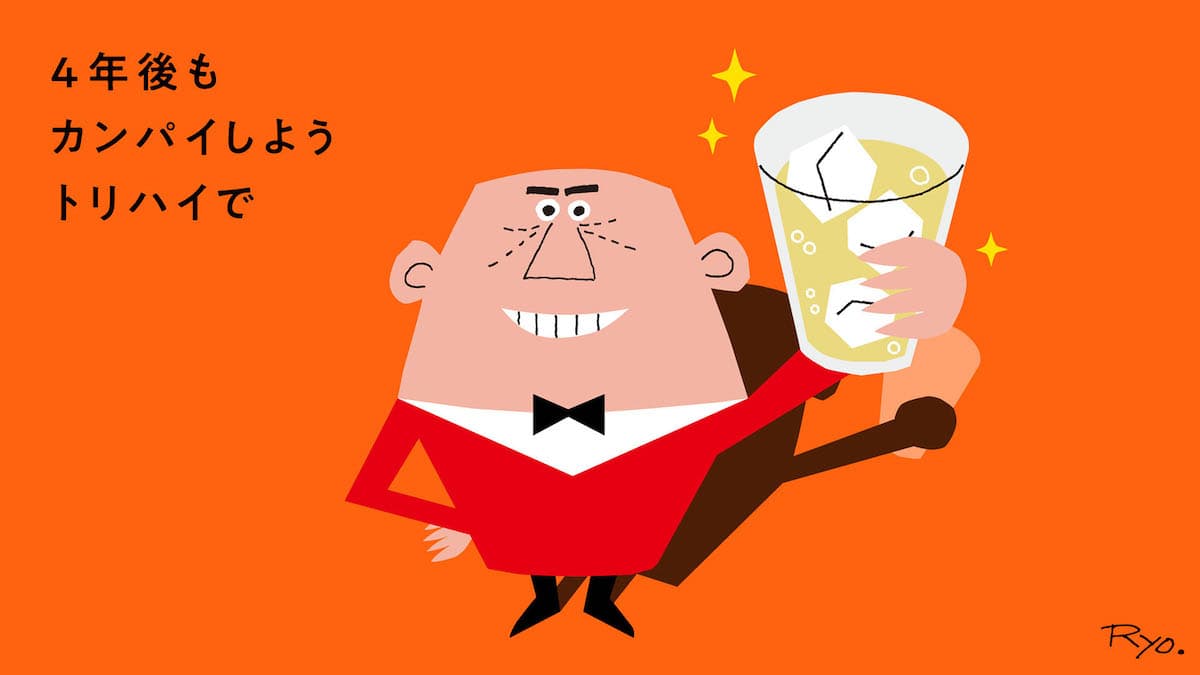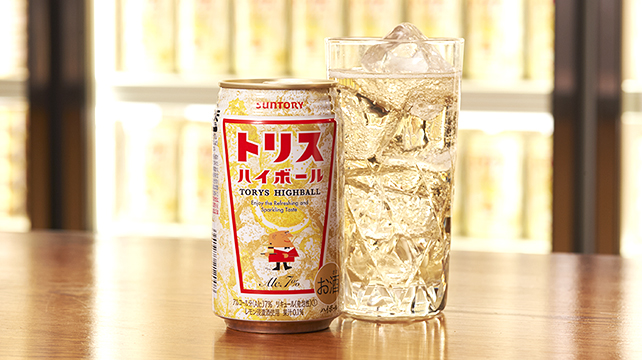During his 62 years on this earth, Uncle Torys has played many roles. He’s been a peace broker to warring cowboys and Indians. He’s proven a hospitable host to interplanetary visitors. He’s wandered the Japanese countryside as a mysterious masked warrior.
But mostly, he’s just a guy who wants a stiff Whisky Highball after a long day at work.
I first encountered Uncle Torys during a search for a stiff Whisky Highball after a long day of non-work while visiting Japan in 2016. As I browsed the canned highballs in the refrigerator section of a 7-Eleven, my eyes caught a label featuring an old-timey cartoon man who wore a red jacket and a black bow tie, as if he were the maître’d of a grand hotel. With my Japanese illiteracy leaving me little else to go on, I plucked the 16-ounce Suntory “Torys Highball” from the cool case and cracked it open outside, an action that would repeat itself many times in the ensuing two weeks.
Later, while visiting Suntory’s Yamazki Distillery, I picked up a postcard that depicted the blocky mascot smiling self-assuredly as he sat at a bar with a glass of whisky. In the corner of the postcard was the word “Ryo,” written like a signature.

Suntory
In the years that followed, my Uncle Torys obsession grew. I discovered a market for secondhand Uncle Torys merchandise on eBay, and for a price I won’t reveal, I picked up a plastic toothpick holder painted in the mascot’s likeness. In his toothpick-holder form, Uncle Torys is not only holding a bottle of Suntory whisky, but also clenching an unlit cigar in his mouth and brandishing a firearm—let’s just say he’s a man of another time. Specifically, the start of what’s known as the Japanese economic miracle.
Torys Bars and Their Mascot Uncle
At the close of the 1950s, Japan was rebounding from the destruction of WWII and building its economy at a rapid pace. This newly invigorated economy gave rise to the “salaryman,” and the formerly flagging Japanese whisky industry began opening bars of its own to furnish office workers with highballs after a long day on the job. As Dominic Roskrow notes in Whisky Japan, industry leader Suntory had opened more than 1,500 “Torys Bars” by the mid-1950s to soak up newly expendable income.
Not content to merely create salaryman-attracting bars, Suntory created a salaryman of its own, debuting Uncle Torys in 1958. According to Kenta Takahashi, who works in the Whisky Marketing Division of Suntory Spirits Limited and responded to my questions via email, Uncle Torys captured the zeitgeist of the time.

Suntory
“Around 1958 was the period that Japan’s economy was growing dramatically after WWII. At that time, office workers believed that working hard would bring bright futures. Uncle Torys refreshes himself and gets energy for the next day drinking alcohol at the bar after work, and his behavior induced a feeling of sympathy for office workers.”
Indeed, a 1958 TV ad depicts an initially glum Uncle Torys entering a bar and downing whiskies in rapid succession, until he leaves red-faced and smiling with a skip in his step. While it’s hard to imagine any company airing a similar ad today—it’s pretty much the opposite of “drink responsibly”—there’s an unmissable current of optimism, from the jazzy soundtrack to the light-hearted animation, that runs through every frame. It seems to embody a once-wrecked nation that is back on its feet and ready to have another, and another one after that.
Creating an Icon
That man responsible for the light-hearted animation was Ryohei Yanagihara, whose “Ryo.” signature graces many pieces of Uncle Torys memorabilia. Yanagihara, who was born in Tokyo in 1931 and passed away in 2015, was a graduate of the Tokyo Arts School and initially began working with Suntory in 1954 as editor of the “Spirits Heaven” magazine distributed in its Torys Bars. Yanagihara left Suntory in 1959 and became one of the country’s best-known animators, but Uncle Torys continued to star in ads throughout the 1960s.
During his commercial run, Uncle Torys was sometimes a participant in genre skits, such as this 1958 spot in which he acts as a whisky-delivering, bad guy-punching sheriff. Or he could be a harried everyman, as in the case of this 1958 ad, in which he’s the only commuter on his train without a canned highball. And in one 1959 spot he seemed to represent the growing fortunes of Japan by promoting what appears to be a Suntory-backed trip to Hawaii.

Suntory
But it wasn’t just on TV that Uncle Torys made his appearances. According to Takahashi, the mascot appeared in newspapers, public transit ads, and highball cans. He was also featured on bar accessories like toothpick holders and coasters, and other promotional products that were either freely distributed or given to customers for buying Torys-brand products.
The amount of time that the Japanese public spent with their animated uncle left an impact. Takahashi claims that the public recognition rate of Uncle Torys is “around 90 percent,” and says that many elderly people in Japan fondly remember the old campaigns.
Still Going Strong
Although Uncle Torys is nearing senior-citizen status himself, he’s shown no signs of retiring. The character still appears on Torys-brand highball cans, and Takahashi points to a 2019 campaign that featured limited edition cans depicting Uncle Torys dressed as a supporter of the Hiroshima Toyo Carp baseball team. Suntory also dedicates a page of its official website to the character, and uploaded a short advertisement (seen below) to its official YouTube page in December 2019 that depicts a young woman and man enjoying a highball beside a magically animate Uncle Torys toothpick holder.
Another 21st century example of Uncle Torys on the airwaves comes courtesy of this 15-second spot, which appears to have aired in Japan in 2010. In the otherwise live-action commercial, a young woman leads a parade of highball-hoisters into a modern-day Torys Bar, which appears decidedly more gender-mixed than the “salaryman” bars of the mid-century. Once inside she is met by Uncle Torys himself, who joins her in clinking highball glasses. The brief ad made me think of another statement I received from Takahashi, in response to my asking why Uncle Torys had proven such a successful mascot.
“He was born as a symbol of office workers at that time and has been changing in accordance with the different image of office workers depending on the times.”
For the final word on Uncle Torys I’ll again defer to Takahashi, who seems to regard the mascot as a valued part of the family.
“He is a good partner who has [helped] gain recognition of the Torys brand, and helped many consumers enjoy it.”



